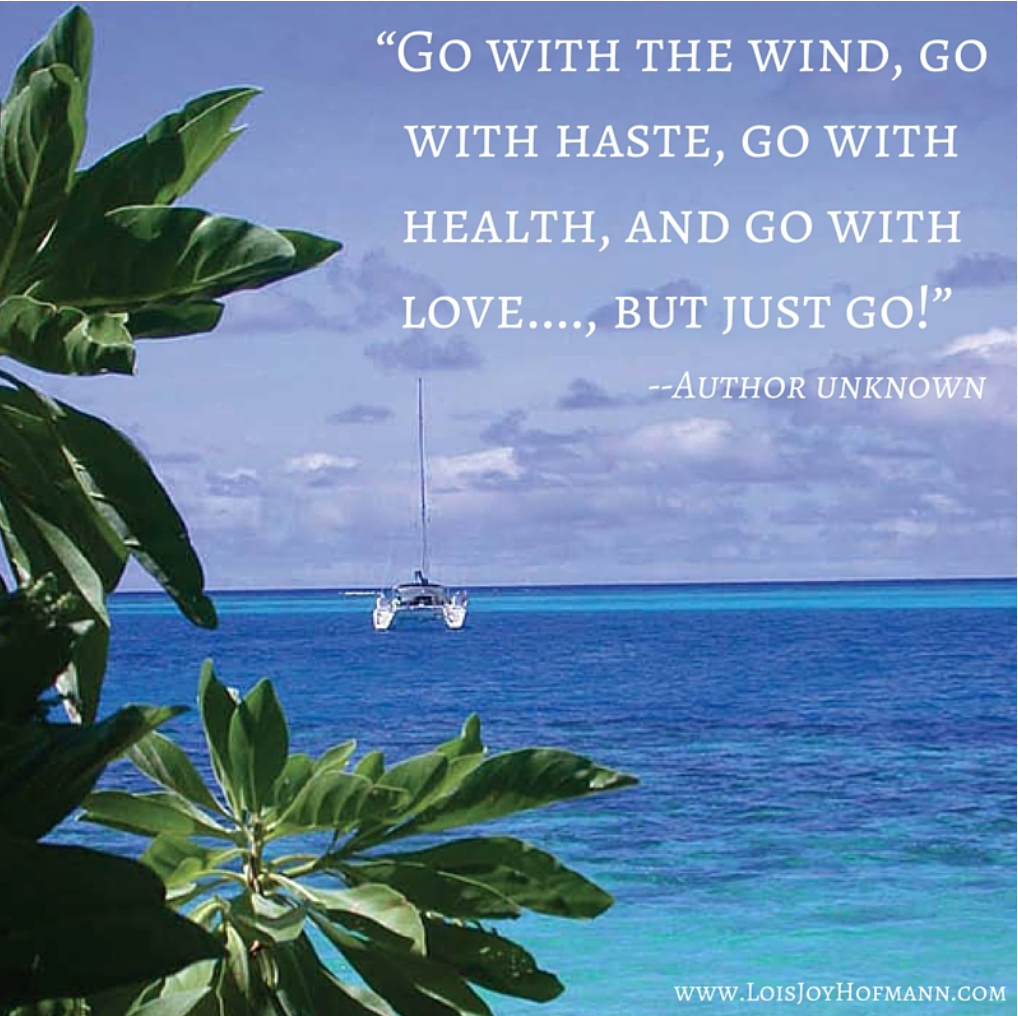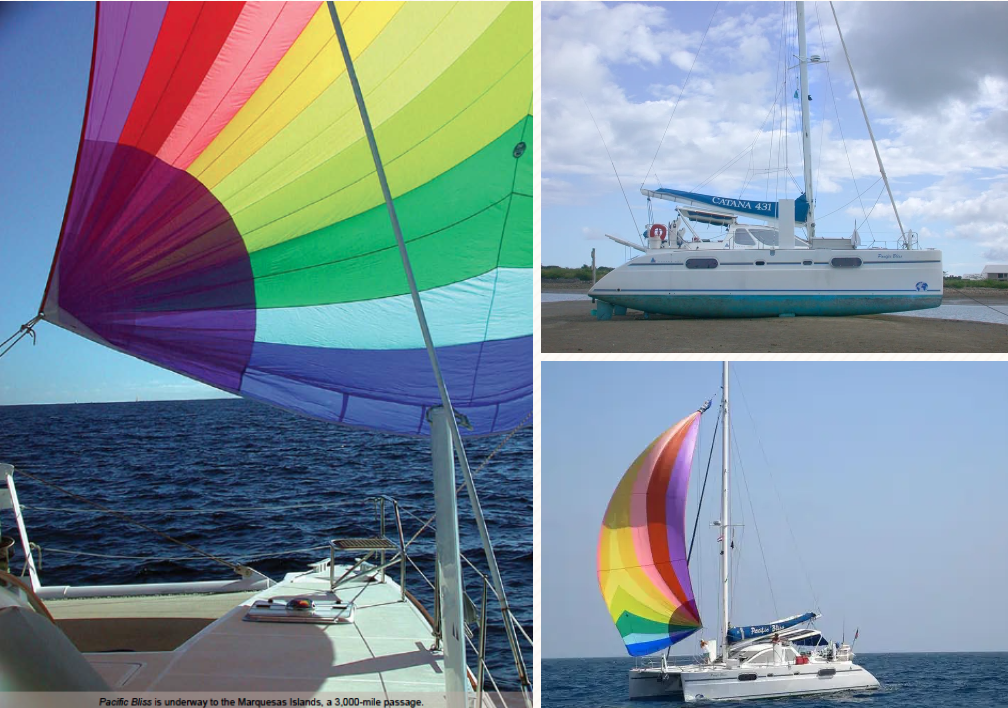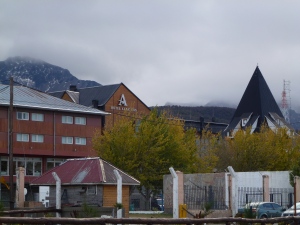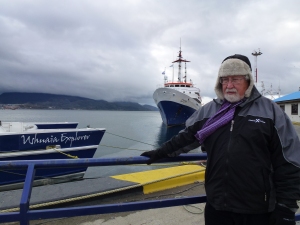As sailors, we’d always wanted to go around Cape Horn. But by the time we purchased a catamaran to sail around the world, our decision had been made. We would be warm-weather sailors on our own yacht. Sailing around the Horn would be a reward we would give ourselves after we completed our circumnavigation. And someone else would be Captain and Navigator. Now that time has come. We are calling our cruise on the Veendam our Big Bucket Cruise. Because not only will we cross many destinations off our “Bucket List,” but Günter had always called the passage to the next port on Pacific Bliss, “moving The Bucket.” And this is one Big Bucket compared to 24×43’ Pacific Bliss! The ms Veendam is 101×720’ with a 24.6’ draft and weighs over 55,000 tons. Built in 1996, she has a crew of 560 and room for 1258 guests. Her max speed is 21 knots.
The names of all the cargo ships of the Holland America line ended in “dijk,” (pronounced dike). But passenger ships were named after dams on rivers, e.g., Amsterdam for the Amster River dam, Maasdam for the Maas River, and Ryndam for the dam on the great river, Rhine. We will sail on a small-to-medium size cruise ship, the Veendam, named after a smaller dam and river.
Buenos Aires, a Capital City with an Edge
Before we board, however, we have scheduled three full days of sightseeing in Buenos Aires, called the “Paris of South America.” We are impressed during our city tour the first day, in a private van with our sailor friends, Joe and Michele. I conclude that Buenos Aires has less sophistication than Paris, but more vibrant colors, a wild, Latin energy, and an undefined edginess that I want to explore further.

In the microcentro, the political and historic center, rust-and-amber cobblestones contrast with shiny steel high-rises. The president comes to work each day to the Casa Rosada, The Pink House, probably along the same Avenida de Mayo that has seen numerous revolutions and bombings. The Plaza here is still the center of a tumultuous political scene, with graffiti and posters and white marks on the concrete where the “women in white,” the mothers of the desaparecidos, (the disappeared ones) still march every Thursday.
The next neighborhood, Puerto Madero, along the riverfront, has rows of restaurants and nightclubs. Farther south, the neighborhoods of La Boca, Monserrat and San Telmo are where the first immigrants arrived from Europe and where the tango originated. (We learn that the tango was originally a lower, working class dance shunned by the elite.)
I am struck by the city’s most European (and exclusive) neighborhood, Recoleta, with its French architecture, tree-lined avenues, and sidewalk cafés. While Günter and Joe sip on cappuccinos and listen to stories about the area’s history told by our guide, Michele and I take a stroll through a charming artisans’ market set up there on Saturdays.
Afterwards, our group spends a couple of hours walking through the city cemetery in Recoleta. Hours? Yes, the cemetery covers four city blocks and Evita is buried there. It is a national treasure where past presidents, war heroes and the elite can continue to show off their wealth. (It’s important to live in Recoleta during one’s life but even more important to lie there after death.) The graves and mausoleums are adorned by the works of national and international sculptors. The stories our guide tells of the plots, murder and mayhem that occurred in this country defy even the most-active imagination!
Even after touring the other neighborhoods, though, we are always happy to return to our Hotel Mine in pleasant Palermo Sojo. On Friday night, the cafés are filled with yuppies stopping for tapas and drinks after work. Michele set up a marvelous wine tasting here, with a formal dinner afterwards. On Saturday night, we walk around the area, and finally settle on a sidewalk café that is celebrating St. Patrick’s Day by promoting local beers.


On Sunday, all the stores in our neighborhood are closed—even the convenience stores and supermarket. The four of us take a taxi to the 270-stand Sunday antiques and flea market that begins in Plaza Dorrego in San Telmo, Buenos Aire’s oldest neighborhood.
“Watch your money,” warns the driver as he lets us off.
We are at an intersection where almost every sign says something about the tango. I step inside the doorway of a store advertising tango shoes. A pretty woman with long, black hair is trying on a red pair of strappy shoes with heels so high that they resemble Jimmy Choo’s.

How can one dance in these?
We pass more shops and then turn onto the blockaded street jammed with souvenirs: hairpieces, scarves, wooden statues, clothing, woolen hats, bags, jewelry, and containers made of gourds for serving make tea. We walk about eight blocks, all the way to the end, then turn around to walk back to the intersection. I fill Günter’s backpack full of souvenirs for friends and relies, along with my little purse, glasses, everything I have so that my hands are free for shopping. This will be my major shopping in Argentina, I rationalize, because during many port stops, we’ll be taking scenic tours.

The midday sun is burning bright and we have forgotten to bring water. We decide to stop at a sidewalk café to order soft drinks. Günter is seated next to a miniature Eiffel Tower. Tourists keep stopping to take photos. The four of us look at his black backpack wedged between his chair and the statue, wondering whether it is in the way, but the tourists don’t seem to mind. Michele leaves to look at some colorful, woven shoes on a table nearby. She motions for me to come. I leave our table for a minute or so and then return. Soon she returns, and we stand to leave. Günter’s backpack is gone! We notify the waitress and the restaurant’s owner, but of course, the thief is long gone. Everyone is carrying a nondescript black backpack, it seems. A few blocks down, we encounter a couple of policemen. They do not speak English, but we manage to convey what happened.
“Documents?” one of them asks.
Günter shakes his head no. “In hotel safe.”
The policeman nods and smiles his approval. It appears that only stealing someone’s identity would be a crime worth reporting.
Later, back at our hotel, we assess the damage. It could have been much worse, even though everything we both had with us, except for the camera I was carrying, was in that pack—including my camera bag, batteries, and memory cards, Günter’s camera and accessories, my prescription reading glasses, my notes, pens, notebook, purse and contents. Of course, we lost all of our carefully selected souvenirs—as well as a special blouse made entirely of ribbons that I had splurged on. The good news: we had taken no passports, billfolds, credit cards, drivers’ licenses, etc.
Lesson learned: Firmly attach all personal items to your person at all times.
We board the ship on Monday, ready for our next adventure, but more cautious than ever.
On the ship, one passenger tells another story. This couple had been robbed in Buenos Aires in a more brazen manner: Two men came up to them, brushing off a spray of guano (bird droppings) from their shoulders, as if to help. But soon afterwards, our shipmate realized that his billfold had been stolen right from his pocket! Then, in the same day, another spray of guano mysteriously fell on them. Wiser now, they realized what these men intended, and pushed away. “Evidently one man sprays the stuff, then brushes it off, while the other steals the billfolds,” she says.
Günter and I realize that we have been fortunate. During our entire eight-year circumnavigation, encompassing 62 countries, we had never been robbed. But then, we’ve never been in edgy Argentina!



















